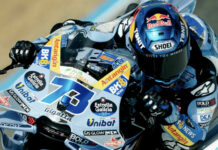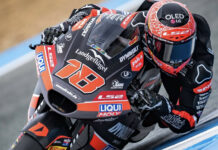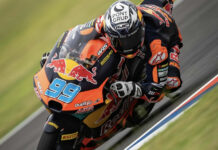Copyright 2003, Roadracing World Publishing, Inc.
The new Road Atlanta chicane was not built to the plans shown to AMA Pro Racing officials, and the final configuration was a surprise.
That shocking revelation was made in the paddock at Pikes Peak International Raceway by AMA Pro Racing Board Member Kevin Schwantz and by AMA Pro Racing Director of Road Racing Ron Barrick.
The chicane was heralded by track officials and in an AMA Pro Racing press release as improving safety by keeping riders away from a concrete wall on the outside of what AMA officials referred to as turn four, a sweeping left-hander prior to the start of the Road Atlanta esses.
No active AMA road racers were consulted prior to the chicane being built, and it has met with almost universal condemnation by riders.
At Pikes Peak, Roadracingworld.com asked riders who had tested at Road Atlanta in April–the first time the chicane was used by AMA teams–if they were consulted prior to the track change being made. All said they had not been consulted, and several said they knew nothing of the change until they saw it on the Internet a few days before the test.
When asked at Pikes Peak why no current riders were contacted before the changes were made, Barrick was quick to point out that former 500cc World Champion Schwantz was consulted.
But Schwantz himself said at Pikes Peak, “I was consulted with regard to the (track) changes beforehand and they looked fine, but what I saw was different than what they actually did. The pictures showed the track going further right into the old turn four before going left. It would have made it less of a straight shot, and more of a chicane.”
Asked if he thought the changes improved safety at Road Atlanta, Schwantz said, “I think the changes help move you away from the wall outside of turn four, but make it more of a straight shot down the hill, and that brings the wall on the inside, at the end of the esses, into play.”
This was clearly shown at Road Atlanta, first when Steve Rapp’s Suzuki hit the inside, and unpadded, wall at the base of the esses during Friday’s Superbike qualifying, and then again when Woody Deatherage crashed into the same, still unpadded, wall during the second Superbike race on Sunday.
Rapp saw the impact coming and bailed out early, avoiding personal contact with the wall. But Deatherage followed his bike into the wall and broke his back.
Like Schwantz, Barrick said that he saw designer Dick Lane’s original design, but that the end result was different. Barrick also said the track didn’t tell him that the chicane design had been changed until after construction was completed, and that the changes to the design were made to keep race cars from tearing up the new chicane’s curbing.
Roadracingworld.com asked some of the riders what they thought of the new section and the general consensus was that it hurt the flow of the track and created new problems.
Yamaha’s Jamie Hacking, the 2002 Road Atlanta 600cc Supersport race winner, said “It’s rinky-dink, flip-flop. All they needed to do was move the outside wall, or just knock it out and add a gravel trap and everything would have been fine.”
Hacking’s teammate Jason DiSalvo said he thought the chicane wasn’t bad, but that it did hurt the flow of the track. He also said he didn’t think it was needed and that all it did was increase the speeds going down the hill.
Austin Ducati’s Anthony Gobert, who in 2002 crashed in the old turn three, breaking his leg, said “I was hurt there but that was a fluke deal, I crashed because of a problem with the bike. They did the same thing at Sears, and I don’t think they are helping anything by just adding some chicane.”
AMA On Road Atlanta Chicane: We Never Saw What They Built
AMA On Road Atlanta Chicane: We Never Saw What They Built
© 2003, Roadracing World Publishing, Inc.






